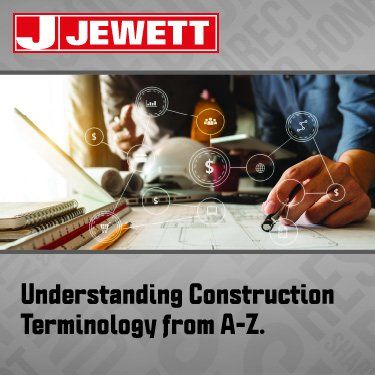Part 2: | Understanding Construction Terminology from A-Z
July 19th, 2024
Part: 2 | Understanding Construction Terminology from A-Z.
7/19/24 | By: William Nartowicz

Demystifying Common Construction Terms.
Welcome to the second installment in our series of blogs on construction terms: Demystifying Common Construction Terms. Every industry has its own jargon, and we wanted to pull back the curtain on ours.
Navigating the construction world can be daunting with its array of specific and technical terms. These phrases often describe design elements, architectural styles, or have unique industry-specific definitions. To help you feel more at ease, we’ve been compiling a list of essential construction terms and their meanings. Whether you’re new to the field or just looking to brush up on your knowledge, these guides will help you understand the language of construction professionals.
ALLOWANCE(S)
Allowances are a sum of money set aside in the construction contract for items which have not been selected and specified in the construction contract. For example, selection of tile as a flooring may require an allowance for an underlayment material, or an electrical allowance which sets aside an amount of money to be spent on electrical fixtures.
BRIDGING
Bridging is either small wood or metal members that are inserted in a diagonal position between the floor joists or rafters at mid-span for the purpose of bracing the joists/rafters & spreading the load.
CONTROL JOINT(S)
Control joints are tooled, straight grooves made on concrete floors to “control” where the concrete should crack.
DRIP CAP
Drip caps are molding, or metal flashing pieces placed on the exterior topside of a door or window frame to cause water to drip beyond the outside of the frame.
ESCUTCHEON
Escutcheons are an ornamental plate that fits around a pipe extending through a wall or floor to hide the cut-out hole.
FIRE STOP / FIRE BLOCK
Fire stops or Fire blocks are solid, tight closure of a concealed space, placed to prevent the spread of fire and smoke through such a space. In a frame wall, this will usually consist of 2 by 4 cross blocking between studs. Work performed to slow the spread of fire and smoke in the walls and ceiling (behind the drywall). Includes stuffing wire holes in the top and bottom plates with insulation and installing blocks of wood between the wall studs at the drop soffit line. This is integral to passing a Rough Frame inspection.
GUSSET
Gussets are flat wood, plywood, or a similar type of member used to provide a connection at the intersection of wood members. Most commonly used at joints of wood trusses. They are fastened by nails, screws, bolts, or adhesives.
HVAC (Heating, Ventilation and Air Conditioning)
HVAC is an abbreviation used to signify the heating, ventilation and cooling structures and systems of the building.
I-JOIST
I-Joists are manufactured structural building components resembling the letter “I”. Used as floor joists and rafters. I-joists include two key parts: flanges and webs. The flange of the I joist may be made of laminated veneer lumber or dimensional lumber, usually formed into a 1 ½” width. The web or center of the I-joist is commonly made of plywood or oriented strand board (OSB). Large holes can be cut in the web to accommodate duct work and plumbing waste lines.
J CHANNEL
J Channels are a widely used and commonly found trim piece in siding installations. Its primary purpose is to create a groove that accommodates the end of a siding panel or soffit panel. J-channels are typically employed around windows, doors, eaves, and soffits. J Channels are also used on the vertical edge of the last drywall sheet.
KING STUD
King studs are the vertical “2 X’s” frame lumber (left and right) of a window or door opening, that runs continuously from the bottom sole plate to the top plate.
LUMENS
Lumens are a unit of measure for total light output. The amount of light falling on a surface of one square foot.
MILLWORK
Millwork is generally all building materials made of finished wood and manufactured in millwork plants. Includes all doors, window and door frames, blinds, mantels, panel work, stairway components (balusters, rail, etc.), moldings, and interior trim. Does not include flooring, ceiling, or siding.
NTE (not-to-exceed)
An NTE is a contract term that means Not to Exceed price. In this contract type, a contractor’s expenditure and scope of work are limited to this value.
ORIENTED STRAND BOARD or OSB
OSB is manufactured as a 4′ X 8′ wood panel made out of 1″- 2″ wood chips and glue. Often used as a substitute for plywood.
PITCH
The incline slope of a roof or the ratio of the total rise to the total width of a house, i.e., a 6-foot rise and 24-foot width is a one-fourth pitch roof. Roof slope is expressed in the inches of rise, per foot of horizontal run.
QUARRY TILE
Quarry tile is a man-made or machine-made clay tile used to finish a floor or wall.
Generally, 6″ X 6″ X 1/4″ thick.
ROUGH-IN
Rough-In is a term used in construction to describe the initial stage of installation for mechanical, electrical, and plumbing lines. It usually takes place after the basic framing is complete, such as the interior walls, floor joists, and sub-flooring. During this stage, the components are connected to provide a basic outline of how the finished product will look, but they are usually not permanently attached.
SPECIFICATIONS or SPECS
Specifications are a narrative list of materials, methods, model numbers, colors, allowances, and other details which supplement the information contained in the blueprints. Written elaboration in specific detail about construction materials and methods. Written to supplement working drawings.
TIME AND MATERIALS CONTRACTS
Time and materials is a contract method where the contractor is paid for the actual costs, which include time and materials.
UNDERPINNING
Underpinning is the process of increasing the depths of existing foundations to transfer loads to stable soils. It is sometimes used to stabilize buildings with shallow foundations when buildings with deep foundations are constructed adjacent to them.
VALUE ENGINEERING
Value engineering is the evaluation of construction methods and/or materials to determine which have the net result of reducing costs, consistent with specified performance, reliability, maintainability, aesthetic, safety, and security criteria.
WATER TABLE
The location of the underground water, and the vertical distance from the surface of the earth to this underground water.
YARD OF CONCRETE
One cubic yard of concrete is 3’x3’x3’ in volume, or 27 cubic feet. One cubic yard of concrete will pour 80 square feet of 3 ½” thick sidewalk or floor.
ZONING
Zoning are governmentregulations that dictate how property areas can be used.
We hope this helps clarify some common terms in Construction. If you missed the first blog, check it out anytime here.
 William Nartowicz
William Nartowicz
Senior Architectural Project Manager
About the Author: William has extensive experience managing residential, commercial, and institutional renovation projects. Outside of work, he enjoys traveling New England, hiking, fishing, ice skating, and exploring local eateries, with a particular fondness for New Hampshire's strong hockey community and numerous lakes and trails.
Jewett Construction through its licensed division Jewett Design LLC. (“Jewett”) provides architectural services.








